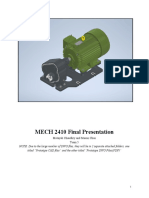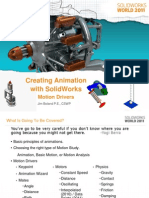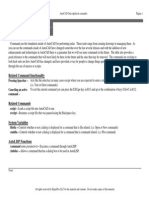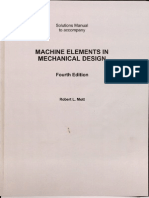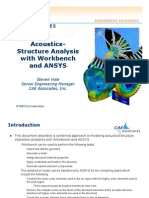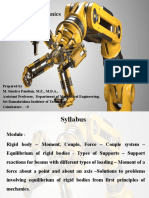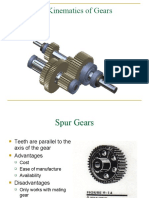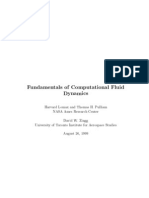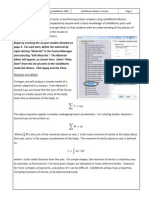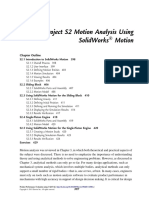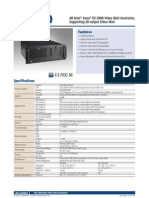SolidWorks Motion Tutorial 2013
SolidWorks Motion Tutorial 2013
Uploaded by
bhumijayaCopyright:
Available Formats
SolidWorks Motion Tutorial 2013
SolidWorks Motion Tutorial 2013
Uploaded by
bhumijayaOriginal Description:
Copyright
Available Formats
Share this document
Did you find this document useful?
Is this content inappropriate?
Copyright:
Available Formats
SolidWorks Motion Tutorial 2013
SolidWorks Motion Tutorial 2013
Uploaded by
bhumijayaCopyright:
Available Formats
IntroductiontoSolidModelingUsingSolidWorks2013
SolidWorksMotionTutorial
Page1
Inthistutorial,wewilllearnthebasicsofperformingmotionanalysisusingSolidWorksMotion.
AlthoughthetutorialcanbecompletedbyanyonewithabasicknowledgeofSolidWorkspartsand
assemblies,wehaveprovidedenoughdetailsothatstudentswithanunderstandingofthephysicsof
mechanicswillbeabletorelatetheresultstothoseobtainedbyhandcalculations.
Wewillbelookingatthreedifferentanalyses:
1. Rotationofawheel,inwhichwewilllearnhowtosetupamotionanalysisandseetheeffectsof
changingthemassmomentofinertiaonangularacceleration.
2. Fourbarlinkage,inwhichwewillseehowplottingaquantitysuchasaccelerationovera
mechanismsfullrangeofmotionallowsustoidentifytheextremevaluesofthequantity.
3. Rolleronaramp,inwhichtheeffectsoffrictionwillbeevaluated.
1. RotationofaWheel
Beginbycreatingthethreepartmodelsdetailedbelow,orbydownloadingthepartsfromthebooks
website.Theeightholepatternoneachwheelisaddedtohelpvisualizationoftherotationofthepart.
IntroductiontoSolidModelingUsingSolidWorks2013
SolidWorksMotionTutorial
Page2
Ifyoudownloadedthepartfiles,thematerialsforthe
partsaredefined.Ifyoucreatedthemyourself,thenfor
eachpart,definethematerialbyrightclickingMaterial
intheFeatureManagerandselectingEditMaterial.The
MaterialEditorwillappear,asshownhere.SelectAlloy
SteelfromthelistofsteelsintheSolidWorksmaterials
library.ClickApplyandthenClose.
Tobegin,wewillanalyzeasimplemodelofawheel
subjectedtoatorque.FromNewtonsSecondLaw,we
knowthatthesumoftheforcesactingonabodyequals
themassofthebodytimestheaccelerationofthebody,or
1
Theaboveequationappliestobodiesundergoinglinearacceleration.Forrotatingbodies,Newtons
SecondLawcanbewrittenas:
2
Where isthesumofthemomentsaboutanaxispassingthroughthebodyscenterofmass, isthe
massmomentofinertiaofthebodyaboutthataxis,and istheangularaccelerationofthebody.The
momentofinertiaaboutanaxisisdefinedas:
3
where istheradialdistancefromtheaxis.Forsimpleshapes,themomentofinertiaisrelativelyeasy
tocalculate,asformulasfor ofbasicshapesaretabulatedinmanyreferencebooks.However,for
morecomplexcomponents,calculationof canbedifficult.SolidWorksallowsmassproperties,
includingmomentsofinertia,tobedeterminedeasily.
OpenthepartWheel1.Fromthemainmenu,selectTools:MassProperties.
Themasspropertiesofthewheelarereportedinthepopupbox.Forthispart,themassis15.29
pounds,andthemomentofinertiaaboutthezaxis(labeledasLzzinSolidWorks)is105.36lbin2.
Notethatifyoucenteredthepartabouttheorigin,thentheproperties,labeledTakenatthecenterof
massandalignedwiththeoutputcoordinatesystemwillbeidenticaltothoselabeledPrincipal
moments...takenatthecenterofmass.Notethattheunitsofmassusedareactuallypoundsmass,
thatis,apartthatweighsonepoundhasamassofonepoundmass.Whenwemakeourcalculations
later,wewillhavetoconvertourvaluessothatweuseunitsofmassthatareconsistentwiththeother
unitsthatweareusing.
IntroductiontoSolidModelingUsingSolidWorks2013
SolidWorksMotionTutorial
Page3
ClosetheMassPropertieswindow.OpenthepartWheel2.Fromthemainmenu,selectTools:Mass
Properties.
Notethatalthoughthemassof15.45isalmostthesameasthatofWheel1,Wheel2smomentof
inertiais146.54lbin2,whichisalmost40%greaterthanthatofWheel1.Thereasonforthedifference
isthatmorematerialinWheel2isplacedneartheouterrim.Inthedefinitionofthemomentofinertia
shownasEqn.3,thecontributionofeachparticleofmassonthevalueof dependsonitsdistancefrom
theaxissquared.Therefore,addingmassneartheouterrimofthewheelincreasesitsmomentof
inertiagreatly.
Openanewassembly.InsertthecomponentBase.
Sincethefirstcomponentinsertedintoanassemblyisfixed,itislogicaltoinsertthecomponent
representingthestationarycomponent(theframeorgroundcomponent)first.
InsertthepartWheel1intotheassembly.SelecttheMateTool.Addaconcentricmatebetween
thecenterholeofthewheelandtheholeinthebase.Besuretoselectthecylindricalfacesforthe
mateandnotedges.Addacoincidentmatebetweenthebackfaceofthewheelandthefrontfaceof
thebase.
Youshouldnowbeabletoclickanddragthewheel,withrotationabouttheaxisofthematedholesthe
onlymotionallowedbythemates.Theadditionofthesetwomateshasaddedarevolutejointtothe
assembly.Arevolutejointissimilartoahingeinthatitallowsonlyonedegreeoffreedom.
ClickontheMotionStudy1tabnearthelowerleft
corner,whichopenstheMotionManageracrossthe
lowerportionofthescreen.
IntroductiontoSolidModelingUsingSolidWorks2013
SolidWorksMotionTutorial
Page4
TheMotionManagercanbeusedtocreatesimulationsofvariouscomplexities:
Animationallowsthesimulationofthemotionwhenvirtualmotorsareappliedtodriveoneor
moreofthecomponentsatspecifiedvelocities,
BasicMotionallowstheadditionofgravityandsprings,aswellascontactbetweencomponents,
tothemodel,and
MotionAnalysis(SolidWorksMotion)allowsforthecalculationofvelocities,accelerations,and
forcesforcomponentsduringthemotion.Italsoallowsforforcestobeappliedtothemodel.
ThefirsttwooptionsarealwaysavailableinSolidWorks.SolidWorksMotionisanaddinprogram,and
mustbeactivatedbeforeitcanbeused.
Fromthemainmenu,chooseTools:AddIns.Inthelistof
availableaddins,clickthecheckboxbesideSolidWorksMotion
toactivateit.ClickOK.
IntroductiontoSolidModelingUsingSolidWorks2013
SolidWorksMotionTutorial
Page5
SelectMotionAnalysisfromthesimulation
optionspulldownmenu.
SelecttheForceTool.
Wewillapplyatorque(moment)tothewheel.Wewill
setthetorquetohaveaconstantvalueof5inlb,and
willapplyitforadurationoftwoseconds.
IntheForcePropertyManager,selectTorqueandthenclickonthefrontfaceofthewheel.
Notethatthearrowshowsthatthetorquewillbeappliedinthecounterclockwisedirectionrelativeto
theZaxis(wesaythatthistorquesdirectionis+Z).Thearrowsdirectlybelowthefaceselectionbox
canbeusedtoreversethedirectionofthetorque,ifdesired.
ScrolldownintheForcePropertyManagerandsetthevalueto5inlb.
ScrollbacktothetopofthePropertyManagerandclickthecheck
marktoapplythetorque.
IntroductiontoSolidModelingUsingSolidWorks2013
SolidWorksMotionTutorial
Page6
IntheMotionManager,clickanddragthediamondshapedicon(termedakey)fromthedefaultfive
secondstothedesiredtwoseconds(00:00:02).SelecttheMotionStudyPropertiesTool,andchange
thecalculationratefromthedefaultof25to100framespersecond.Clickthecheckmark.
Usingalargernumberofframespersecondwillresultinsmootherplots,butwillrequiremore
calculationtime.
ClicktheCalculatorIcontoperformthesimulation.
Theanimationofthesimulationcanbeplayedbackwithoutrepeating
thecalculationsbyclickingthePlayfromStartkey.Thespeedofthe
playbackcanbecontrolledfromthepulldownmenubesidethePlay
controls.
Asnotedearlier,SolidWorksMotionprovidesquantitativeanalysis
resultsinadditiontoqualitativeanimationsofmotionmodels.Wewillcreateplotsoftheangular
accelerationandangularvelocityofthewheel.
SelecttheResultsandPlotsTool.InthePropertyManager,usethepulldownmenustoselect
Displacement/Velocity/Acceleration:AngularAcceleration:ZComponent.Clickonthefrontfaceof
thewheel,andclickthecheckmark.
IntroductiontoSolidModelingUsingSolidWorks2013
SolidWorksMotionTutorial
Page7
Aplotwillbecreatedoftheangularacceleration
versustime.Theplotcanbedraggedaroundthe
screenandresized.Itcanalsobeeditedbyright
clickingtheplotentitytobemodified,similartothe
editingofaMicrosoftExcelplot.
Weseethattheaccelerationisaconstantvalue,
about1050degreespersecondsquared.Sincethe
appliedtorqueisconstant,itmakessensethatthe
angularaccelerationisalsoconstant.Wecancheck
thevaluewithhandcalculations.Notethatwhilewe
canperformverycomplexanalyseswithSolidWorksMotion,checkingamodelbyapplyingsimpleloads
ormotionsandcheckingresultsbyhandisgoodpracticeandcanpreventmanyerrors.
Weearlierfoundthemassmomentofinertiatobe105.36lbin2.Sincethepoundisactuallyaunitof
force,notmass,weneedtoconvertweighttomassbydividingbythegravitationalacceleration(
.Sinceweareusinginchesasourunitsoflength,wewilluseavalueof386.1in/s2:
105.36 lb in
in
386.1
s
0.2729 lb in s 4
Sincethetorqueisequaltothemassmomentofinertiatimestheangularacceleration,wecanfindthe
angularaccelerationas:
5 in lb
0.2729 lb in s
18.323
rad
5
s
Noticethatthenondimensionalquantityradiansappearsinouranswer.Sincewewantouranswerin
termsofdegrees,wemustmakeonemoreconversion:
18.323
rad 180 deg
rad
s
1050
deg
6
s
ThisvalueagreeswithourSolidWorksMotionresult.
SelecttheResultsandPlotsTool.InthePropertyManager,usethepulldownmenustoselect
Displacement/Velocity/Acceleration:AngularVelocity:ZComponent.Clickonthefrontfaceofthe
wheel,andclickthecheckmark.Resizeandmovetheplotsothatbothplotscanbeseen,andformat
theplotasdesired.
IntroductiontoSolidModelingUsingSolidWorks2013
SolidWorksMotionTutorial
Page8
Asexpected,sincetheaccelerationisconstant,thevelocityincreaseslinearly.Thevelocityattheendof
twosecondsisseentobeabout2100degreespersecond.Thisresultcanbeverifiedwithasimplehand
calculation:
1050
deg
s
2 s
2100
deg
7
s
Often,theangularvelocityisexpressedinrevolutionsperminute(rpm),commonlydenotedbythe
symbol :
2100
deg
s
1 rev
360 deg
60 s
1 min
350 rpm 8
Wewillnowexperimentwithvariationsofthesimulation.
Movetheplotsoutoftheway,butdonotclosethem.Clickanddragthekeyatthetopofthe
simulationtreefrom2secondstofour,sothatthesimulationwillnowlastforfourseconds.Placethe
cursoronthelinecorrespondingtotheappliedtorque(Torque1)atthe2secondmark.(Ifdesired,you
canclickthe+andsignsattherightendofthetimelinetoscalethetimeline.)Rightclickandselect
Off.
Anewkeywillbeplacedatthatlocation.Thetorquewillnowbeappliedfortwoseconds,butthe
simulationwillcontinueforthefourseconds.
IntroductiontoSolidModelingUsingSolidWorks2013
SolidWorksMotionTutorial
Page9
PresstheCalculatoricontoperformthesimulation.
Theplotswillbeautomaticallyupdated.Notethattheangularaccelerationnowdropstozeroattwo
seconds,whiletheangularvelocitywillbeconstantaftertwoseconds.Sincethereisnofrictioninthe
model,thewheelwillcontinuetospinataconstantvelocitywithoutanytorqueapplied.
Intheprevioussimulations,thetorquewasappliedasaconstantvalue.Thatmeansthatthechangeof
theaccelerationrelativetotime(commonlyreferredtoasjerk)isinfiniteattime=0andattime=2
seconds.Amorerealisticapproximationistoassumethatthetorquebuildsupoversomeperiodof
time,andalsorampsdowngradually.Forexample,wewillassumethatittakestwosecondstoreach
thefullvalueoftorqueandtwosecondstorampdown.
Rightclickthekeyaddedtothetorqueattime=2secondsanddeleteit.Movethekeydefiningthe
durationofthesimulationtosixseconds.
Movethetimebarbacktozero.RightclickonTorque1andselectEditFeature.
ScrolldowninthePropertyManager,andselect
SegmentsasthetypeofForceFunction.Enterthethree
rowsasshownhere,withCubicastheSegmentType.
IntroductiontoSolidModelingUsingSolidWorks2013
SolidWorksMotionTutorial
Page10
Twographsaredisplayed:thetorqueasafunctionoftimeandthe
derivativeofthetorque.Youcanexperimentwithdifferentsegment
typestoseehowtheyaffectthetorque,butthecubiccurvewillwork
fineforthisexample.
ClickOKandthenthecheckmarktoapplythetorque.Calculatethe
simulation.
Notethattheangularaccelerationcurveissmooth,andpeaksat1050deg/s2.Attheendofthesix
seconds,thewheelwillbeturningatabout4,200deg/s(700rpm).
NowletsseetheeffectofreplacingtheWheel1componentwithWheel2,whichhasahighermass
momentofinertia.Ofcourse,wecouldstartwithanewassembly,butitiseasiertoreplacethe
componentintheexistingassembly.Thiswillallowustoretainmostoftheassemblymatesand
simulationentities.
Clickthemodeltabatthebottomofthescreen.ClickonWheel1intheFeatureManagertoselectit.
Fromthemainmenu,selectFile:Replace.BrowsetofindWheel2.InthePropertyManager,clickthe
checkmarktoacceptthereplacementoffacesintheexistingmateswiththoseofthenewpart.Click
thecheckmarktomakethereplacement.
IntroductiontoSolidModelingUsingSolidWorks2013
SolidWorksMotionTutorial
Page11
Dependingonhowyoumodeledtheparts,itispossiblethaterrorswillbeencounteredwhenthe
programattemptstoreapplythemates.Ifthishappens,closetheerrormessages,deletebothmates,
andapplynewmatesmanually.
SwitchtotheMotionStudy.Rightclickeachtorque,selectEditFeature,andclickonthefrontfaceof
thewheeltodefinethedirection.Inthesimulationtree,rightclickoneachplot,andclickonthefront
faceofthewheeltodefinethecomponentforwhichvelocity/accelerationistobeplotted.Calculate
thesimulation.
IntroductiontoSolidModelingUsingSolidWorks2013
SolidWorksMotionTutorial
Page12
Notethatthemaximumangularaccelerationisabout755deg/s2,whichissignificantlylessthatofthe
simulationwiththeearlierwheel.Thisvaluecanbeverifiedfromtheratio:
9
105.36
deg
1050
146.54
s
755
deg
10
s
2. FourBarLinkage
Inthisexercise,wewillmodela4barlinkagesimilartothatofChapter11ofthetext.Inthetext,we
wereabletoqualitativelysimulatethemotionofthesimulationwhendrivenbyaconstantspeed
motor.Inthisexercise,wewilladdaforceandalsoexploremoreofthequantitativeanalysistools
availablewithSolidWorksMotion.
Downloadorconstructthecomponentsofthelinkageshownonthenextpage,andassemblethemas
detailedinChapter11ofthetext.ThematerialshouldbeAlloySteelforalloftheparts.TheFramelink
shouldbeplacedintheassemblyfirst,sothatitisthefixedlink.
YoushouldbeabletoclickanddragtheCranklinkaroundafull360degreerotation.
NotethattheConnectorlinkhasthreeholes.Themotionofthethirdholecanfollowmanypaths,
dependingonthegeometryofthelinksandthepositionofthehole.
IntroductiontoSolidModelingUsingSolidWorks2013
SolidWorksMotionTutorial
Page13
Beforebeginningthesimulation,wewillsetthelinkstoapreciseorientation.Thiswillallowusto
compareourresultstohandcalculationsmoreeasily.
Addaperpendicularmatebetweenthetwofacesshownhere.
ExpandtheMatesgroupofthe
FeatureManager,andrightclickonthe
perpendicularmatejustadded.Select
Suppress.
Theperpendicularmatealignsthecranklinkatapreciselocation.However,
wewantthecranktobeabletorotate,sowehavesuppressedthemate.Wecouldhavedeletedthe
mate,butifweneedtorealignthecranklater,wecansimplyunsuppressthemateratherthan
recreatingit.
IntroductiontoSolidModelingUsingSolidWorks2013
SolidWorksMotionTutorial
Page14
SwitchtotheFrontView.Zoomoutsothattheviewlookssimilartotheoneshownhere.
TheMotionManagerusesthelastview/zoomofthemodelasthestartingviewforthesimulation.
MakesurethattheSolidWorksMotionaddinisactive.ClicktheMotionManagertab.
SetthetypeofanalysistoMotionAnalysis.SelecttheMotoricon.Inthe
PropertyManager,setthevelocityto60rpm.Clickonthefrontfaceofthe
Cranktoapplythemotor,andclickthecheckmark.
IntroductiontoSolidModelingUsingSolidWorks2013
SolidWorksMotionTutorial
Page15
Clickanddragthesimulationkeyfromthedefault
fivesecondstoonesecond(0:00:01).
Sincewesetthemotorsvelocityto60rpm,aone
secondsimulationwillincludeonefullrevolutionof
theCrank.
ClicktheMotionStudyPropertiesTool.UndertheSolidWorksMotiontab,set
thenumberofframesto100(framespersecond),andclickthecheckmark.
Thissettingwillproduceasmoothsimulation.
ChooseSolidWorksMotionfromthepull
downmenu,andpresstheCalculatoriconto
runthesimulation.
ClicktheResultsandPlotsTools.InthePropertyManager,setthetypeoftheresulttoDisplacement/
Velocity/Acceleration:TracePath.ClickontheedgeoftheopenholeoftheConnector.
Playbackthesimulationtoseetheopenholespathoverthefull
revolutionoftheCrank.
Ifdesired,youcanaddpathsfor
theothertwojointsthatundergo
motion.
IntroductiontoSolidModelingUsingSolidWorks2013
SolidWorksMotionTutorial
Page16
Thefourbarlinkagecanbedesignedtoproduceavarietyofmotionpaths,asillustratedbelow.
Wewillnowaddaforcetotheopenhole.
SelecttheForceTool.InthePropertyManager,thehighlightedboxpromptsyouforthelocationofthe
force.Clickontheedgeoftheopenhole,andtheforcewillbeappliedatthecenterofthehole.
Thedirectionboxisnowhighlighted.Rotateandzoominsothatyoucanselectthetopfaceofthe
Framepart.Theforcewillbeappliednormaltothisforce.Asyoucansee,theforceactsupwards.
Clickthearrowstoreversethedirectionof
theforce.
IntroductiontoSolidModelingUsingSolidWorks2013
SolidWorksMotionTutorial
Page17
ScrolldowninthePropertyManagerandsetthemagnitudeofthe
forceto20pounds.Clickthecheckmarktoapplytheforce.
Runthesimulation.
Wewillnowplotthetorqueofthemotorthatisrequiredtoproduce
the60rpmmotionwiththe20lbloadapplied.
SelectResultsandPlots.Inthe
PropertyManager,specifyForces:Applied
Torque:ZComponent.Clickonthe
RotaryMotorintheMotionManagertoselect
it,andclickthecheckmarkinthe
PropertyManager.
Formattheresultingplotasdesired.
Notethattheappliedtorquepeaksatabout51inlb.Att=0,thetorqueappearstobeabout30inlb
(thenegativesignsindicatesthedirectionisabouttheZaxis,orclockwisewhenviewedfromtheFront
View).Inordertogetamoreexactvalue,wecanexportthenumericalvaluestoaCSV(comma
separatedvalues)filethatcanbereadinWordorExcel.
RightclickinthegraphandchooseExportCSV.Savethefiletoa
convenientlocation,andopenitinExcel.
IntroductiontoSolidModelingUsingSolidWorks2013
SolidWorksMotionTutorial
Page18
Attime=0,weseethatthemotortorqueis29.2
inlb.
Handcalculationsforastaticanalysisofthe
mechanismareattached,whichshowavalueof
29.4inlb.
Itisimportantwhencomparingthesevaluesto
recognizetheassumptionsthatarepresentinthe
handcalculations:
1. Theweightsofthememberswerenot
includedintheforces,and
2. Theaccelerationsofthememberswereneglected.
Thefirstassumptioniscommoninmachinedesign,astheweightsofthemembersareusuallysmallin
comparisontotheappliedloads.Incivilengineering,thisisusuallynotthecase,astheweightsof
structuressuchasbuildingandbridgesareoftengreaterthantheappliedforces.
Thesecondassumptionwillbevalidonlyiftheaccelerationsarerelativelylow.Inourcase,theangular
velocityofthecrank(60rpm,oronerevolutionpersecond)producesaccelerationsinthemembersthat
aresmallenoughtobeignored.Letsaddgravitytothesimulationtoseeitseffect.
ClickontheGravityicon.InthePropertyManager,selectYasthedirection.Therewillbeanarrow
pointingdowninthelowerrightcornerofthegraphicsarea,showingthatthedirectioniscorrect.
Clickthecheckmark.Runthesimulation.
Thetorqueplotisalmostunchanged,withthepeak
torqueincreasingbyonlyoneinlb.Therefore,omittinggravityhadverylittleeffectonthecalculations.
Nowwewillincreasethevelocityofthemotortoseetheeffectonthetorque.
IntroductiontoSolidModelingUsingSolidWorks2013
SolidWorksMotionTutorial
Page19
Dragthekeyattheendofthetopbarinthe
MotionManagerfrom1secondto0.1second.Usethe
ZoomInToolinthelowerrightcornerofthe
MotionManagertospreadoutthetime
line,ifdesired.
Dragthesliderbarshowingthetimewithinthesimulation
backtozero.
Thisisanimportantstepbeforeeditingexistingmodel
items,aschangescanbeappliedatdifferenttimesteps.
Becausewewantthemotorsspeedtobechangedfrom
thebeginningofthesimulation,itisimportanttosetthe
simulationtimeatzero.
RightclickontheRotaryMotorintheMotionManager.Inthe
PropertyManager,setthespeedto600rpm.Clickthecheckmark.
Sinceafullrevolutionwilloccurinonly0.1seconds,weneedtoincrease
theframerateofthesimulationtoachieveasmoothplot.
SelecttheMotionStudyProperties.InthePropertyManager,settheSolidWorksMotionframerateto
1000frames/second.Clickthecheckmark.
Runthesimulation.(ClickNoifyoureceiveamessageaskingifyouwant
toincreasethesimulationtime.)
IntroductiontoSolidModelingUsingSolidWorks2013
SolidWorksMotionTutorial
Page20
Thepeaktorquehasincreasedfrom51to180inlb,
demonstratingthatasthespeedisincreased,the
accelerationsofthemembersarethecriticalfactors
affectingthetorque.
Youcanverifythisconclusionfurtherbysuppressing
bothgravityandtheapplied20lbloadandrepeating
thesimulation.Thepeaktorqueisdecreasedonly
from180to151inlb,evenwithnoexternalloads
applied.
Toperformhandcalculationswiththeaccelerationsincluded,itisnecessarytofirstperformakinematic
analysistodeterminethetranslationalandangularaccelerationsofthemembers.Youcanthendraw
freebodydiagramsofthethreemovingmembersandapplythreeequationsofmotiontoeach:
F
ma F
ma M
Theresultisnineequationsthatmustbesolvedsimultaneouslytofindthenineunknownquantities(the
appliedtorqueandthetwocomponentsofforceateachofthefourpinjoints).
Theresultsapplytoonlyasinglepointintime.Thisisamajoradvantageofusingasimulationprogram
suchasSolidWorksMotion:sinceitisnotevidentatwhatpointinthemotionthattheforcesare
maximized,ouranalysisevaluatestheforcesoverthecompleterangeofthemechanismsmotionand
allowsustoidentifythecriticalconfiguration.
IntroductiontoSolidModelingUsingSolidWorks2013
SolidWorksMotionTutorial
Page21
3.RolleronaRamp
Inthisexercise,wewilladdcontactbetweentwobodies,andexperimentwithfrictionbetweenthe
bodies.Wewillbeginbycreatingtwonewpartsarampandaroller(skipthesestepsifyouhave
downloadedtheparts).
Openanewpart.IntheFrontPlane,sketchanddimensionthetriangleshownhere.
Extrudethetriangleusingthemidplaneoption,withathicknessof1.2inches.
IntheTopPlane,usingtheCorner
RectangleTool,drawarectangle.
Addamidpointrelationbetweenthe
leftedgeoftherectangleandthe
origin.Addthetwodimensions
shown,andextrudetherectangle
down0.5inches.
Modifythematerial/appearanceasdesired(shownhereas
Pine).SavethispartwiththenameRamp.
Openanewpart.Sketchanddimensiona
oneinchdiametercircleintheFrontPlane.
Extrudethecirclewiththemidplaneoption,
toatotalthicknessofoneinch.Setthe
materialofthepartasPVCRigid.Modify
thecolorofthepartasdesired(overriding
thedefaultcolorofthematerialselected).
IntroductiontoSolidModelingUsingSolidWorks2013
SolidWorksMotionTutorial
Page22
Openanewsketchonthefrontfaceofthecylinder.
Addanddimensionthecirclesandlinesasshownhere
(thepartisshowninwireframemodeforclarity).The
twodiagonallinesaresymmetricaboutthevertical
centerline.
ExtrudeacutwiththeThroughAlloption,withthesketchcontoursshownselected.Ifdesired,change
thecolorofthecutfeature.
Createacircularpatternoftheextrudedcutfeatures,withfive
equallyspacedcuts.SavethepartwiththenameRoller.
Openanewassembly.Inserttherampfirst,andplaceitattheoriginoftheassembly.Insertthe
Roller.
IntroductiontoSolidModelingUsingSolidWorks2013
SolidWorksMotionTutorial
Page23
Addtwomatesbetweentherampandtheroller.MatetheRightPlanesofbothparts,andadda
tangentmatebetweenthecylindricalsurfaceoftherollerandthesurfaceoftheramp.
Thebestwaytosetthecorrectheightoftherollerontherampisto
addamatedefiningthepositionoftheaxisoftheroller.
FromtheHeadsUpViewToolbar,selectView:TemporaryAxes.
Thiscommandturnsonthedisplayofaxesthatareassociatedwith
cylindricalfeatures.
Addadistancematebetweentherollersaxisandtheflat
surfaceatthebottomoftheramp.Setthedistanceas6.5
inches.
Sincetheradiusoftherolleris0.5
inches,theaxiswillbe0.5inches
abovetheflatsurfacewhenthe
surfaceoftherollercontactsthat
surface.Therefore,thevertical
distancetraveledbytherollerwill
be6.0inches.Also,notethatthe
distancetravelleddowntheramp
willbe12inches(6inchesdivided
bythesineoftherampangle,30
degrees).
IntroductiontoSolidModelingUsingSolidWorks2013
SolidWorksMotionTutorial
Page24
Turnoffthetemporaryaxisdisplay.SwitchtotheMotionStudy.SelectSolidWorksSimulationasthe
typeofanalysis.Addgravityintheydirection.
SelecttheContactTool.InthePropertyManager,youwillbepromptedto
selectthebodiesforwhichcontactcanoccur.Clickoneachofthetwo
parts.ClearthecheckboxeslabeledMaterialandFriction.Leavethe
otherpropertiesastheirdefaults.
Wewilladdfrictionlater,butourinitialsimulationwillbeeasiertoverifywithoutfriction.IntheElastic
Propertiessection,notethatthedefaultissetasImpact,withseveralotherproperties(stiffness,
exponent,etc.)specified.Ateachtimestep,theprogramwillcheckforinterferencebetweenthe
selectedbodies.Ifthereisinterference,thenthespecifiedparametersdefineanonlinearspringthat
actstopushthebodiesapart.Contactsaddconsiderablecomplexitytoasimulation.Ifthetimesteps
aretoolarge,thenthecontactmaynotberecognizedandthebodieswillbeallowedtopassthrough
eachother,oranumericalerrormayresult.
SelecttheMotionStudiesPropertyTool.Settheframerateto500andchecktheboxlabeledUse
PreciseContact.Clickthecheckmark.
Forsomesimulations,itmaybenecessarytolowerthesolutiontoleranceinordertogetthesimulation
torun.Forthisexample,thedefaulttoleranceshouldbefine.
Thematesthatweaddedbetweenthepartstopreciselylocatetherollerontherampwillprevent
motionoftheroller.Ratherthandeletethesemates,wecansuppressthemintheMotionManager.
RightclickoneachofthematesintheMotionManagerandselectSuppress.Runthesimulation.
Youwillseethattherollerreachesthebottomoftherampquickly.
Changethedurationofthesimulationto0.5seconds,andrunthesimulationagain.Createaplotof
themagnitudeofthelinearvelocityoftherollervs.time.
Therollerreachesthebottomoftherampinabout0.35seconds,andthevelocityatthebottomofthe
rampisabout68in/s.Thesevaluesagreewiththosecalculatedintheattachmentattheendofthis
document.
IntroductiontoSolidModelingUsingSolidWorks2013
SolidWorksMotionTutorial
Page25
Nowletsaddfriction.
Movethetimelineofthesimulationbacktozero.RightclickonthecontactintheMotionManager
tree,andselectEditFeature.ChecktheFrictionbox,andsetthecoefficientoffrictionto0.25.
Calculatethesimulation.
Theresultingvelocityplotshowsthevelocityatthebottomoftheramptobeabout54in/s.Thisvalue
agreeswiththatofthecalculationsshownintheattachment.
Toconfirmthattherollerisnotslipping,wecantrace
thepositionofasinglepointontheroller.
SelecttheResultsandPlotsTool.Definetheplotas
Displacement/Velocity/Acceleration:TracePath.
Clickonapointneartheouterrimoftheroller(not
onaface,butonasinglepoint).Clickthecheck
mark.
Thetracepathshowssharpcuspswherethe
pointsvelocityapproacheszero(itwillnot
becomeexactlyzerounlessthepointisonthe
outersurfaceoftheroller).Forcomparison,
repeattheanalysiswithalowerfriction
coefficient.
IntroductiontoSolidModelingUsingSolidWorks2013
SolidWorksMotionTutorial
Page26
Changethefrictioncoefficientto0.15andrecalculatethesimulation.
Thistime,thetracepathsshowssmoothcurves
whenthepointisneartherampssurface,
indicatingthatslidingandrollingaretaking
placesimultaneously.
Intheattachment,itisshownthatthe
coefficientoffrictionrequiretopreventslipping
isabout0.21.
Itisinterestingtonotethatthefrictioncoefficienttopreventslippingandthetimerequiredtoreachthe
bottomoftheramparebothfunctionsoftheratioofthemomentofinertiatothemassoftheroller.(A
parametercalledtheradiusofgyrationisdefinedasthesquarerootofthemassmomentofinertia
dividedbythemass,andisafunctiononlyofthepartsgeometry.)Youcanconfirmthisbychangingthe
materialoftherollerandseeingthattheresultsofthesimulationareunchanged.However,ifyou
changethegeometryoftheroller(theeasiestwayisbysuppressingthecutoutregions),thenthe
resultswillchange.
IntroductiontoSolidModelingUsingSolidWorks2013
SolidWorksMotionTutorial
Page27
ATTACHMENT:VERIFICATIONCALCULATIONS
STATICANALYSISOFFOURBARLINKAGESUBJECTEDTO20LBAPPLIEDFORCE
FreebodydiagramofConnector:
NotethatmemberCDisa2forcemember,andsotheforceattheendisalignedalongthemembers
axis.
Applyequilibriumequations:
M
5.714 in
sin 75.09
5.522 in
1.832 in
cos 75.09
0.4714 in
5.993 in
228.5 in lb
228.5 in lb
228.5 in lb
5.993 in
38.13 lb
38.13 lb cos 75.09
9.812 lb
11.427 in 20 lb
IntroductiontoSolidModelingUsingSolidWorks2013
SolidWorksMotionTutorial
Page28
38.13 lb sin 75.09
20 lb
16.85 lb
FreebodydiagramofCrank:
NotethatBxandByareshowninoppositedirectionsasinConnectorFBD.
SummomentsaboutA:
M
3 in
3 in 9.812 lb
0
29.4 in lb
IntroductiontoSolidModelingUsingSolidWorks2013
SolidWorksMotionTutorial
Page29
ROLLERCALCULATIONS
NoFriction:
Freebodydiagram:
W sin
W cos
Whereistherampangle(30degrees)
Sincetheweightisequalthemassmtimesthegravitationalaccelerationg,theaccelerationinthex
direction x willbe:
g sin
x
Theaccelerationisintegratedwithrespecttotimetofindthevelocityinthexdirection:
g sin d
g sin
vxo
Wherevxo istheinitialvelocityinthexdirection.Thevelocityisintegratedtofindthedistancetravelled
inthexdirection:
g
g sin
v d
sin
v
x
2
Wherex0 istheinitialposition.Ifwemeasurexfromthestartingposition,thenx0 iszero.Iftheblockis
initiallyatrest,thenvxo isalsozero.Inoursimulation,theblockwillslideadistanceof12inchesbefore
contactingthebottomoftheramp(seethefigureonpage23).
Knowingthedistancetravelledinthexdirection,andenteringthenumericalvaluesofgas386.1in/s2
andofsin of0.5(sinof30o),wecanfindthetimeittakestheblocktoslidetothebottom:
IntroductiontoSolidModelingUsingSolidWorks2013
12 in
or
SolidWorksMotionTutorial
386.1 ins
2
0.5
Page30
0.353 s
SubstitutingthisvalueintoEquation4,wefindthevelocityatthebottomoftheramp:
in
in
386.1 2 0.5 0.353 s
68.1
x
s
s
Thisvelocitycanalsobefoundbyequatingthepotentialenergywhentherollerisatthetopoftheramp
(heightabovethedatumequals6inches)tothekineticenergywhentherollerisatthebottomofthe
ramp:
1
2
2
2 386.1
in
6 in
s
68.1
in
s
FrictionIncluded:
FreeBodyDiagram:
Whiletherollerwithoutfrictionslidesandcanbetreatedasaparticle,therollerwithfriction
experiencesrigidbodyrotation.Theequationsofequilibriumare:
F
W sin
N
M
W cos
r
IntroductiontoSolidModelingUsingSolidWorks2013
SolidWorksMotionTutorial
Page31
Ifthereisnoslipping,thentherelativevelocityoftheroller
relativetotherampiszeroatthepointwherethetwo
bodiesareincontact(pointO).Sincetherampis
stationary,thisleadstotheobservationthatthevelocityof
pointOisalsozero.
SincepointOisthecenterofrotationoftheroller,the
tangentialaccelerationofthecenteroftheroller x can
bewrittenas:
r
x
Substitutingthisexpressionintothefirstequilibriumequationandsolvingforthefrictionforce,
W sin mr
Substitutingthisexpressionintothethirdequilibriumequationandsolvingfortheangularacceleration
,
W sin mr r Io
W sin r I
mr
W sin r
I
mr
ThemassandthemomentofintertiaI canbeobtainedfromSolidWorks.Fortheroller,thevaluesare:
m 0. 017163 lb
0.002515 lb in
I
Sincepoundsareunitsofweight,notmass,theyquantitiesabovemustbedividedbygtoobtainthe
quantitiesinconsistentunits:
m
0. 017163 lb
386.1 in/s
0.002515 lb in
386.1 in/s
4.4453 X 10
lb s
in
6.5139 X 10 lb in s
Thevalueoftheangularaccelerationcannowbefound:
W sin r
I
mr
0. 017163 lb sin 30
6.5139e
6 lb in s
4.4453
0.5 in
lb s
5
in
243.4
0.5 in
rad
IntroductiontoSolidModelingUsingSolidWorks2013
SolidWorksMotionTutorial
Page32
Therefore,thelinearaccelerationinthexdirectionis:
r
0.5 in
243.4
rad
121. 7
s2
Integratingtoobtainthevelocityandpositionatanytime:
1
2
vxo
v
121. 7
in
s2
in
s2
60.85
in
s
Fortherollertotravel12inchesinthe direction,thetimerequiredis
12 in
60.85 ins
Andthevelocityatthebottomoftherampis:
121. 7
Wecanalsocalculatethefrictionforce:
W sin
mr
in
0.444 s
2
0. 017163 lb sin 30
0.444 s
54.0
4.4453 e
in
s
lb s
in
0.5
243.4
rad
s
0.00318 lb
Fromthesecondequilibriumequation,thenormalforceis:
N
W cos
0. 017163 lb cos 30
0.1486 lb
Sincethemaximumfrictionforceisthecoefficientoffriction timesthenormalforce,thecoefficientof
frictionmustbeatleast:
0.00318 lb
0.1486 lb
0.21
Thisistheminimumcoefficientoffrictionrequiredfortherollertorollwithoutslipping.
You might also like
- Serial Number AOE 3Document1 pageSerial Number AOE 3bhumijaya65% (20)
- WBv12.1 Emag Tutorial3 Busbars PDFDocument58 pagesWBv12.1 Emag Tutorial3 Busbars PDFAraz SNo ratings yet
- Daniel Master Thesis PresentationDocument47 pagesDaniel Master Thesis PresentationBuluc GheorgheNo ratings yet
- Adams Online Course Adm701Document1 pageAdams Online Course Adm701Adil HossainNo ratings yet
- Stanley Cobotics BrochureDocument12 pagesStanley Cobotics BrochureEberthsonNo ratings yet
- MECH 2410 Final Presentation: Titled "Prototype CAD Files" and The Other Titled "Prototype DWG Files (PDF) "Document17 pagesMECH 2410 Final Presentation: Titled "Prototype CAD Files" and The Other Titled "Prototype DWG Files (PDF) "Ana-Maria BogatuNo ratings yet
- Low Cost Manual Barrier 3-4.5mDocument1 pageLow Cost Manual Barrier 3-4.5mbhumijayaNo ratings yet
- SolidWorks Motion Tutorial 2010Document31 pagesSolidWorks Motion Tutorial 2010Hector Adan Lopez GarciaNo ratings yet
- SolidWorks Motion AnalysisDocument37 pagesSolidWorks Motion AnalysisivNo ratings yet
- Creating Motion in SolidWorks-Motion DriversDocument58 pagesCreating Motion in SolidWorks-Motion DriversManuj AroraNo ratings yet
- COSMOS Motion TutorialDocument11 pagesCOSMOS Motion TutorialFabio MedeirosNo ratings yet
- The Inventor MentorDocument271 pagesThe Inventor MentorΑρετή Σταματούρου100% (1)
- AutoCAD 2006 Commands Quick GuideDocument34 pagesAutoCAD 2006 Commands Quick GuideMarco100% (1)
- CFD Studies of Combustion in Diesel EngineDocument4 pagesCFD Studies of Combustion in Diesel Enginedeepali0305100% (1)
- Technical ReferenceDocument120 pagesTechnical ReferenceMatias GuardiaNo ratings yet
- 353 35435 ME357 2011 4 2 1 Sheet MD2Document10 pages353 35435 ME357 2011 4 2 1 Sheet MD2adel nabhanNo ratings yet
- Parametric Design: EngineeringdesignDocument11 pagesParametric Design: EngineeringdesignJhon Leyder Rodriguez OrtizNo ratings yet
- Engg Sol ManualDocument133 pagesEngg Sol Manualmiddieman147100% (6)
- Ansys Forte SectorMesh Tutorial r170Document16 pagesAnsys Forte SectorMesh Tutorial r170vovanpedenko100% (1)
- AcousticsDocument12 pagesAcousticsaguzhNo ratings yet
- Solid Works Training Files PDFDocument1 pageSolid Works Training Files PDFdanxl007No ratings yet
- Fundamentals of 3d Design and SimulationDocument73 pagesFundamentals of 3d Design and Simulation690392379No ratings yet
- Crank and Slotted Lever Quick Return (Rev2)Document9 pagesCrank and Slotted Lever Quick Return (Rev2)Vipin YadavNo ratings yet
- Engineering Mechanics Unit 2Document109 pagesEngineering Mechanics Unit 2SundraNo ratings yet
- Mechanical Design Animation TutorialDocument16 pagesMechanical Design Animation TutorialAnonymous pMVR77x1No ratings yet
- Using Adams/View - MD Adams 2010Document1,556 pagesUsing Adams/View - MD Adams 2010pkokatam100% (1)
- Tut10 Modal Analysis of A Cantilever Beam Using AnsysDocument9 pagesTut10 Modal Analysis of A Cantilever Beam Using AnsysMaher KattanNo ratings yet
- Sprocket ForcesDocument7 pagesSprocket ForcesAyan Jain100% (1)
- To Determine The Moment of Inertia of A FlywheelDocument2 pagesTo Determine The Moment of Inertia of A FlywheelCHEE HONG CHANNo ratings yet
- Chapter 8 - Kinematics of GearsDocument37 pagesChapter 8 - Kinematics of GearskbashokNo ratings yet
- Fundamentals of 3D Design and Simulation: Solidworks Education Edition 2016-2017Document21 pagesFundamentals of 3D Design and Simulation: Solidworks Education Edition 2016-2017enda bayongNo ratings yet
- SolidWorks Training Files2010Document2 pagesSolidWorks Training Files2010scribdztNo ratings yet
- RecurDyn 版本6高级训练手册Document47 pagesRecurDyn 版本6高级训练手册Jou0411100% (1)
- 1700 Animated 3Document143 pages1700 Animated 3Aquino MiguelNo ratings yet
- CSWP Core Sample Exam 2009Document9 pagesCSWP Core Sample Exam 2009Jose Luis AtaullucoNo ratings yet
- CAD Instructor Guide: Engineering Design and Technology SeriesDocument60 pagesCAD Instructor Guide: Engineering Design and Technology SeriesakhilNo ratings yet
- Whats New Solidworks 2020Document213 pagesWhats New Solidworks 2020tariq100% (1)
- HES3350 Machine Design Semester 1 2012 Assignment 1 Compound Reverted Gear Train Design PDFDocument18 pagesHES3350 Machine Design Semester 1 2012 Assignment 1 Compound Reverted Gear Train Design PDFrisirarocksNo ratings yet
- ANSYS Modal AnalysisDocument40 pagesANSYS Modal AnalysisDesmond Chang100% (1)
- Design of Brakes: Energy Equations in BrakesDocument27 pagesDesign of Brakes: Energy Equations in BrakesManoj SP100% (1)
- Assessment of Mesh-Free Methods in LsdynaDocument91 pagesAssessment of Mesh-Free Methods in LsdynaeronelNo ratings yet
- Solidworks: SOLIDWORKS Simulation Premium: NonlinearDocument8 pagesSolidworks: SOLIDWORKS Simulation Premium: NonlinearPhoenix WorldNo ratings yet
- WL CR Adv Mec V1 en PDFDocument269 pagesWL CR Adv Mec V1 en PDFAjayNo ratings yet
- CFD HandbookDocument275 pagesCFD HandbookWahid AliNo ratings yet
- Hands-On Simulation Modeling with Python,: Develop simulation models for improved efficiency and precision in the decision-making processFrom EverandHands-On Simulation Modeling with Python,: Develop simulation models for improved efficiency and precision in the decision-making processNo ratings yet
- SolidWorks Motion Tutorial 2012Document31 pagesSolidWorks Motion Tutorial 2012Felipe DiazNo ratings yet
- Solidworks MotionDocument13 pagesSolidworks MotionJulio Cesar Montoya DelgadoNo ratings yet
- SolidWorks Motion Tutorial 2018Document33 pagesSolidWorks Motion Tutorial 2018jimmy jimenez barriosNo ratings yet
- Solid Works Motion Tutorial 2009Document21 pagesSolid Works Motion Tutorial 2009tornnado_No ratings yet
- Project S2 Motion Analysis UsingSolidWorksDocument35 pagesProject S2 Motion Analysis UsingSolidWorksIsrael GarduñoNo ratings yet
- Project S2 Motion Analysis Using Solidworks Motion: Chapter OutlineDocument35 pagesProject S2 Motion Analysis Using Solidworks Motion: Chapter OutlineIsrael GarduñoNo ratings yet
- Motorcycle Dynamics Library in ModelicaDocument10 pagesMotorcycle Dynamics Library in ModelicaSaufiy SarminNo ratings yet
- SolidWorks Motion AnalysisDocument37 pagesSolidWorks Motion Analysiswidi_115No ratings yet
- SolidWorks Motion AnalysisDocument37 pagesSolidWorks Motion AnalysisAnonymous rI9NBeE5No ratings yet
- SolidWorks Motion Study TutorialDocument37 pagesSolidWorks Motion Study TutorialVega R JoseNo ratings yet
- SolidWorks Motion Study TutorialDocument37 pagesSolidWorks Motion Study TutorialwawanUAINo ratings yet
- Installations Win7Document3 pagesInstallations Win7bhumijayaNo ratings yet
- Windows 1eh2vpeDocument38 pagesWindows 1eh2vpebhumijayaNo ratings yet
- Installations Win7Document3 pagesInstallations Win7bhumijayaNo ratings yet
- Features: 4U Intel Xeon E5-2600 Video Wall Controller, Supporting 20-Output Video WallDocument2 pagesFeatures: 4U Intel Xeon E5-2600 Video Wall Controller, Supporting 20-Output Video WallbhumijayaNo ratings yet
- Laser Ion Source With Solenoid FieldDocument6 pagesLaser Ion Source With Solenoid FieldbhumijayaNo ratings yet
- 163 Laser SelenoidDocument1 page163 Laser SelenoidbhumijayaNo ratings yet
- Video Project Proposal Video TitleDocument4 pagesVideo Project Proposal Video TitlebhumijayaNo ratings yet
- MEDIAJET - MARKEM-IMAJE 9028 Inkjet Printer Head InstallationDocument4 pagesMEDIAJET - MARKEM-IMAJE 9028 Inkjet Printer Head Installationbhumijaya100% (1)
- Water Tank - FinalDocument4 pagesWater Tank - FinalricardovomNo ratings yet
- 06robotics - TimersDocument10 pages06robotics - TimersbhumijayaNo ratings yet
- AGV UpdateDocument4 pagesAGV UpdatebhumijayaNo ratings yet
- Sheet MetalDocument42 pagesSheet MetalNavtej Singh100% (3)
- Simulation Validation CasesDocument136 pagesSimulation Validation CasesPriyesh SaxenaNo ratings yet
- Optimal Design Methodology For An AGV Transportation System by Using The Queuing Network TheoryDocument10 pagesOptimal Design Methodology For An AGV Transportation System by Using The Queuing Network TheorybhumijayaNo ratings yet





